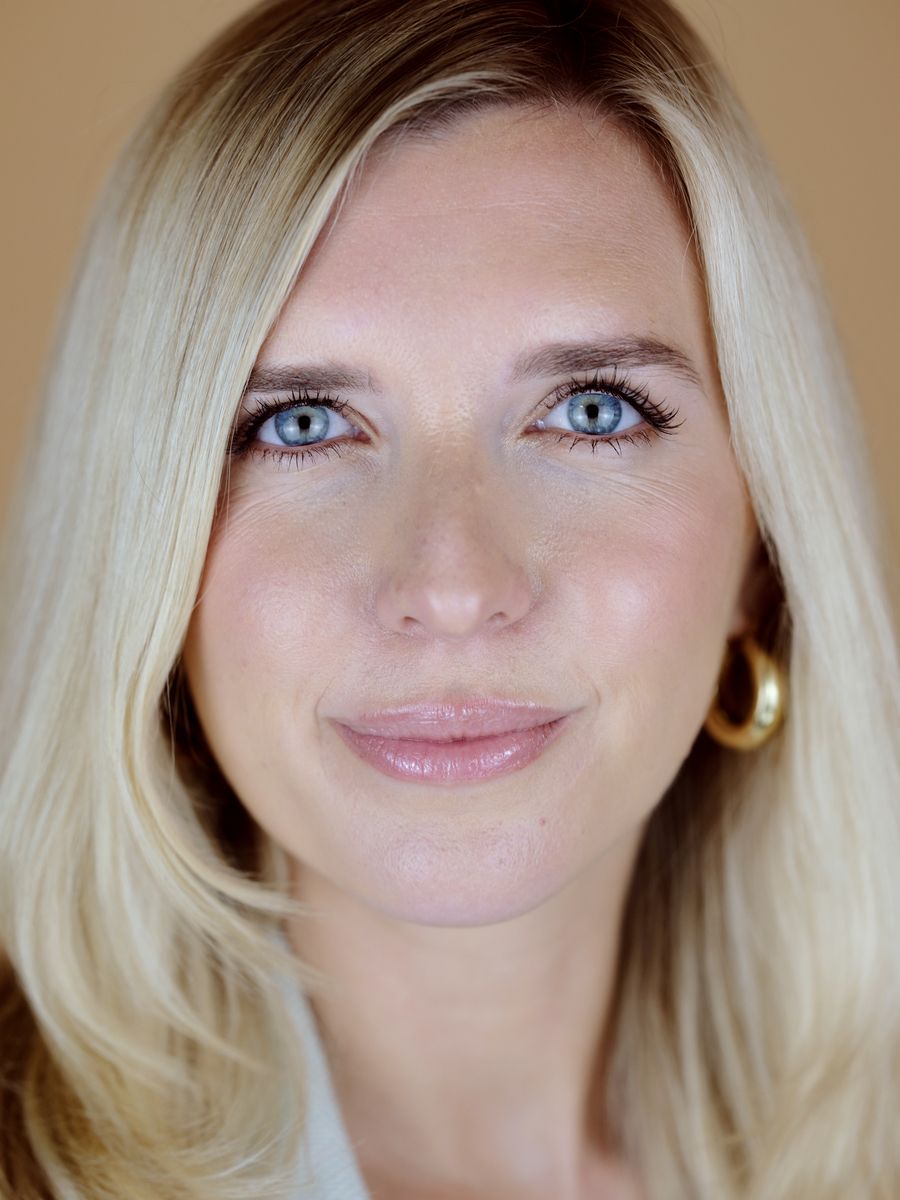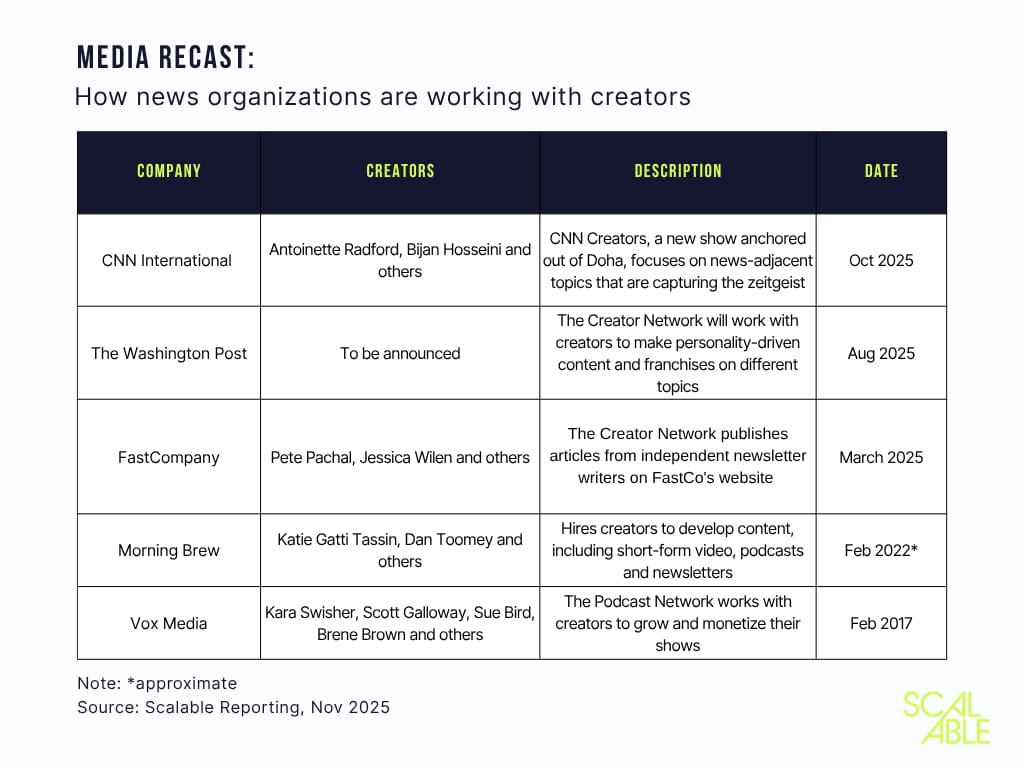One theme we’ve been thinking a lot about is the future of news and information, and how the news industry is converging with the creator economy.
As you can see from the table above, news outlets have been trying out different approaches to respond to changes in how—and where—people consume information.
Some news outlets have been at it for a while: The Vox Media Podcast Network has been around since 2017. But what’s new now is that it's focusing more on video and expanding its offerings to help its talent build media businesses. On Monday, relationship guru Esther Perel, who is part of the podcast network, launched a Substack.
It’s easy to cite layoffs and shakeups at media businesses as reasons for the convergence of creators with the news industry. Those were the primary catalysts during the pandemic when an initial wave of journalists turned to Substack. But these current moves by legacy media feel less like a knee-jerk reaction to macro-challenges and more like a strategic play to adapt to the changing face of news.
News outlets are now dealing with the double whammy of people turning to social media apps and individual creators for news, while also navigating a newer and more tangible threat: the rise of AI search, which is disrupting SEO and direct traffic to their sites. In the UK, DMG Media, which owns MailOnline and other outlets, said that AI overviews have resulted in a decline of up to 89% in click-through rates.
These organizations are also grappling with a continued decline in trust in mass media and institutions, especially among young people who feel unrepresented by the voices and stories on traditional news outlets. In October, Gallup reported that Americans’ confidence in mass media hit a record low of just 28%, down from 40% in late 2020.
As we wrote in last week’s newsletter, working more closely with creators is an opportunity for established institutions to breathe new life into their offerings.
But it also raises all sorts of thorny challenges for news outlets: Are creators they work with held to the same fact-checking standards? What happens when a creator gets canceled? Are these media organizations willing to loosen up, or risk landing flat with younger audiences?
Many creators who share news on their accounts rely on third-party sources for information. (Very few of them are actually on the ground reporting themselves!) Others don’t have any journalism training and may inadvertently, or on purpose, share misinformation.
To mitigate those risks, some news organizations are taking a more middle-of-the-road approach. CNN International’s new initiative, for example, taps existing employees rather than independent creators for a new broadcast show and other content focused on “news-adjacent topics and stories that feel real, relevant and relatable,” rather than hard news.
The Wall Street Journal is also looking to develop homegrown talent: It recently posted a job listing for a “talent coach” to help its journalists behave more like creators and develop personal brands online.
The challenge is that in-house creators could eventually outgrow the brand they work for and become the competition. That fear is warranted: We’re also now in a new wave of traditional journalists going at it alone. This time, they have a clearer roadmap on how to succeed, as well as partners or backers—sometimes from outside the news industry—to support them.
In July, Dave Jorgenson, who architected The Washington Post’s popular TikTok account, left the newspaper to launch his own media venture Local News International (LNI). The channel hit nearly 100,000 YouTube subscribers on its first day. Now, the Post is building its own Creator Network.
But the risk of news outlets not adapting to this new era of news and information is greater. And the reality is that these hybrid approaches are a win for creators and journalists-turned-creators, too: They provide more security while allowing them to better capitalize and grow their personal brands.
Take Alex Heath for example. The former deputy editor for Vox Media-owned The Verge launched a new tech publication called Sources on Substack in September. But he is retaining a relationship with his previous employer—and its audience. One edition of Sources per week will also be available on The Verge’s website and he’s also co-hosting a podcast that’s part of the Vox Media Podcast Network.
What this all shows is that there’s plenty of room for both traditional journalists and creators, including at the same company. Some of these efforts will work, and others will fail. But one thing is for sure: It’s a new era for media.
In other news…
By the Numbers: $50 Billion
Meta Platforms’ Reels now has an annual revenue run rate of $50 billion, according to the company’s third-quarter results. For context, that’s more than both TikTok ($26.4 billion) and YouTube ($36.2 billion) generated in ad revenue in 2024, per company reports and EMARKETER estimates.
In other words: If Meta were to spin off Reels into its own app—as Kaya reported it was considering earlier this year—Reels could easily be the largest short-form video app based on ad revenue, assuming it continued on the same trajectory.
We’ll be breaking down what else you need to know from big tech earnings on our podcast on Thursday. You can also read Jasmine’s take on Q3 earnings on CNBC here.
The Round Up
It’s Election Day in the US! Zohran Mamdani, the frontrunner to become the next mayor of New York City, hosted a news conference with about 70 creators at his campaign headquarters last week. Mamdani also appeared on Mad Realities’ TikTok and Instagram show Shop Cats, about cats that live in New York City bodegas.
According to the New York City Board of Elections, more than 735,000 ballots were cast during the nine days of early voting, which is four times higher than the early vote count during the 2021 mayoral race. Over half of early voters this year were under 55.
Netflix is in discussions to license video podcasts distributed by iHeartMedia, Bloomberg reported. Netflix wants these shows to be exclusive to its streaming service, so full episodes would no longer be available on YouTube, similar to the terms of a deal it recently inked with Spotify and The Ringer. iHeartRadio shows include “Stuff You Should Know” and the “Jay Shetty Podcast.”
Netflix has also sent out dozens of requests to agents at CAA, UTA and WME to bring on more video podcasters, according to The Hollywood Reporter. We’ll be talking more about Netflix’s podcast ambitions during Thursday’s podcast.
Google and Disney are locked in a fee dispute, resulting in Disney channels including ESPN and ABC going dark on YouTube TV. Disney asked YouTube to offer ABC to YouTube TV customers on Tuesday for Election Night coverage, but YouTube declined, saying it could cause “customer confusion” to restore access for only a day.
TikTok announced its first-ever U.S. awards show called TikTok Awards, which will take place on December 18 at the Hollywood Palladium in Los Angeles. It will also be livestreamed on TikTok and on Tubi, which has recently ramped up its creator push. Award nominees include Alix Earle, Alex Warren and Adam W.
Whatnot, a live shopping startup, raised $225 million in Series F funding co-led by DST Global and CapitalG at a valuation of $11.5 billion. That’s more than double its valuation in January.
Rolling Stone magazine is turning its past interviews, including conversations with Bob Dylan, Ray Charles and Eddie Murphy, into a new video podcast series on its YouTube channel, Spotify and other audio streaming platforms. It’s an interesting example of how media companies are repurposing past content and reformatting it.
Talent Tracker
⭐First in Scalable: Andre Jones joined TikTok’s creator management team overseeing agency relations. Most recently, he was a digital agent at WME.
Creator Moves
Steven Bartlett, host of the “Diary of a CEO” podcast, announced last week that his holding company Steven.com closed new funding led by Slow Ventures and Apeiron Investment Group that values his company at $425 million. “Diary of a CEO” has more than 13 million YouTube subscribers and is ranked No.19 in Spotify’s top podcasts.
Audiochuck, a true crime media company founded by podcast host Ashley Flowers, signed a $150 million deal with Fox Corp.-owned Tubi, which will stream video versions of its “Crime Junkie” podcast on the ad-supported streaming service. The move shows how video is opening up new opportunities for podcasters to sign different types of deals beyond advertising. And video deals are looking lucrative. For comparison: Last year, Alex Cooper’s Unwell Network signed a $100 million deal with SiriusXM for advertising rights.
Anthony Potero, the YouTuber better known as Anthpo, co-founded a new marketing company called Pufferfish with Talia Schulhof, which will help brands make viral ads. Potero was behind the viral Timothée Chalamet look-alike contest.
Make-A-Wish requests to meet influencers have more than doubled in the past 10 years, according to Axios. Those requests now make up 32% of the wishes granted by the nonprofit within the entertainment industry, the second biggest category behind music.
Soundbite
“Joe Rogan’s the Facebook of podcasting,” said Democratic California Governor Gavin Newsom to host Elex Michaelson on the first episode of CNN’s new show “The Story Is.”
“The Joe Rogan Experience” was the No.1 podcast in the US during the third quarter, per Edison Research, a position it has held since at least the second quarter of 2023. But recent reports, like this one from Bloomberg, suggest that the single-host podcast format with recurring guests may be in need of reinvention. That’s not unlike Facebook: It has a massive audience, but has lost relevance.



